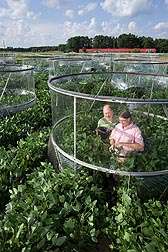Replicating Climate Change to Forecast its Effects

(PhysOrg.com) -- Agricultural Research Service (ARS) scientists are replicating the effects of climate change to see what the future holds for soybeans, wheat and the soils where they grow.
Soybeans, wheat, and a number of other crops grow more when carbon dioxide levels are elevated because the increased carbon is thought to give the plants more "food." But those same plants are damaged and stunted by elevated levels of ozone, a ground-level gas created when sunlight heats up automotive and industrial pollutants. Levels of both gases are expected to rise as the climate warms.
Fitzgerald Booker, Kent Burkey and Edwin Fiscus, researchers at the ARS Plant Science Research Unit in Raleigh, N.C., are using 16 open-top chambers to expose wheat and soybeans to the levels of carbon dioxide and ozone that may be reached by 2050. By that time, carbon dioxide levels may be about 1.5 times greater than the current 380 parts per million, and daytime ozone levels in the summer, now at about 50 to 55 parts per billion, may rise 20 percent. The goal of the study is to assess the effects of climate change on growth rates, crop yields and soil chemistry.
The researchers have four sets of four chambers: a set with elevated ozone, another with elevated carbon dioxide, a set with both gases elevated, and four "control" chambers without elevated levels of either gas. They also are leaving plant stems, empty pods and dead leaves in the chambers, and are not plowing the soil to mimic conditions found in no-till farming. In this type of cropping system, elevated carbon dioxide levels may increase soil decomposition and slow down the accumulation of carbon in the soil.
Preliminary results show just slightly higher levels of soil carbon in chambers with elevated carbon dioxide and in chambers with elevated levels of both carbon dioxide and ozone, but not in chambers with elevated ozone alone. Elevating carbon dioxide also reduced flour protein levels in wheat by 7 to 11 percent, but soybean protein concentrations were maintained because of soybeans' ability to acquire nitrogen from the air.
This research supports the U.S. Department of Agriculture priority of responding to climate change. Read more about the research in the November-December 2009 issue of Agricultural Research magazine.
Provided by USDA Agricultural Research Service


















